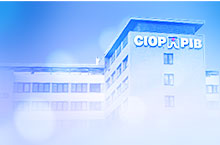|
| | | | | | | | | | | | | | | | | | | | | | | | | | | | | | | | | | | | | | | | | | | | |
|
|
 |
The principles of establishing MAC values of harmful chemical compounds in the working environment
Slawomir Czerczak
The paper presents the history of hygienic standards in Poland, as well as the current situation, and a system of establishing Polish MAC values for chemical compounds in the working environment.
Full documentation is successively published in Polish in the Principles and Methods of Assessing the Working Environmental.
Benzothiazol – determination method
Ewa Kozieł
The method is based on the adsorption of benzothiazol vapours on ORBO-43, desorption with chloroform and a gas chromatographic (GC-FPD) analysis of the resulting solution.
The determination limit of the method is 2.5 mg/m³.
Bromochlorometan – determination method
Barbara Romanowicz
The method is based on the adsorption of bromochlorometan vapours on activated charcoal. Samples are desorbed with carbon disulfide and analyzed by gas chromatography with a flame ionization detector (GC-FID).
The determination limit of the method is 100 mg/m³.
2-(2-Buthoxyethoxy)etanol – determination metod
Wiktor Wesołowski, Małgorzata Kucharska
The method is based on the adsorption of 2-(2-buthoxyethoxy)ethanol on charcoal, desorption with 5% solution of methanol in dichloromethane and a gas chromatographic analysis of the resulting solution.
The determination limit of the method is 10 mg/m³.
2-Chlorobuta-1,3-diene – determination method
Anna Jeżewska
The method is based on the adsorption of 2-chlorobuta-1,3-diene vapours on active charcoal, desorption with carbon disulfide and a gas chromatographic (GC-FID) analysis of the obtained solution.
The determination limit of the method is 0,25 mg/m³.
Dimethyl disulfide – determination method
Joanna Kowalska
The determination method is based on the adsorption of dimethyl disulfide vapours on activated charcoal (100/50 mg sections), desorption with dichloromethane and a gas chromatographic with flame ionization detection (GC-FID) analysis of the resulting solution.
The determination limit of the method is 0.3 mg/m³.
Allyl glycidyl ether – determination method
Anna Jeżewska
The method is based on the adsorption of allyl glycidyl ether vapours on active charcoal, desorption with a solvent mixture (dichloromethane, methanol) and a gas chromatographic (GC-FID) analysis of the obtained solution.
The determination limit of the method is 0.75 mg/m³.
2-Ethylhexanol – determination method
Anna Jeżewska
The method is based on the adsorption of 2-ethylhexanol vapours on active charcoal, desorption with dichloromethane and a gas chromatographic (GC-FID) analysis of the obtained solution.
The determination limit of the method is 20 mg/m³.
n-Heptane – determination method
Barbara Romanowicz
The method is based on the adsorption of n-heptane vapours on activated charcoal. Samples are desorbed with carbon disulfide and analyzed by gas chromatography with a flame ionization detector (GC-FID).
The determination limit of the method is 60 mg/m³.
2,2'-Iminodiethanol – determination method
Krystyna Wróblewska-Jakubowska
Air samples are collected by drawing a known volume of air through polipropylene filters. Filters are transferred into vials and extracted with a methanol-water mixture. The obtained extracts are analyzed by gas chromatography with flame ionization detection (GC-FID).
The determination limit of the method is 2.25 mg/m³.
Parathion-methyl – determination method
Teresa Nazimek
This method is based on the adsorption of parathion-methyl vapours on silica gel with chemically bounded oc-tadecyl phase ODS-C18, extraction of the compound with diethyl ether and then determination in the obtained solution by capillary gas chromatography (GC-NPD).
The determination limit of this method is 0.025 mg/m³.
 |
Chrisotile asbestos
Edward Więcek, Helena Woźniak
Chrisotile asbestos Mg3(Si2O5(OH)8 is a hydrated silicate of magnesium and it belongs to the group of serpen-tine minerals. Chrisotile fibres have many uses, mostly in the production of asbestos-cement, textile, insulating and friction products.
Occupational exposure to asbestos dusts can cause the following diseases: asbestosis, lung cancer, and consid-erably more seldom mesothelioma.
For asbestosis and lung cancer the relationship between the biological effect and the cumulated dose of asbestos fibres has been proved. The risk of developing mesothelioma is relative to the time that elapses from the first exposure to asbestos fibres.
Taking into account data from epidemiological and experimental studies the following values are proposed: oc-cupational exposure limit (OEL) for dusts containing chrisotile and other fibrous minerals except for crocidolite - 0.2 fb/cm³ instead of the compulsory value - 0.5 fb/cm³.
There are no bases to change OEL for total dust, which is 1.0 mg/m³.
 |
|








